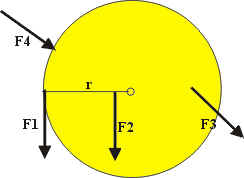
Torque Makes the Wheel go Round!
Think of torque as being an application of a force in a way that tends to make something rotate.
If you took your finger and tried to get a record turntable rotating you find it easier if you apply a tangential forace at the rim of the turntable vs. near the center; Likewise, you want to push tangentially rather than radially.

For the turntable shown here, F1 - F4 all have the same magnitude. Which one is most effective in getting the turntable to accelerate??
F3 and F4 are not good choices because they have large radial components (you are pushing sideways on the bearing with these forces). F4 is useless (it is all radial) F3 would do you a small amount of good.
F1 and F2 are candidates because they both are tangential -- But F1 is more effective than F2 because of the greater distance from the axis of rotation.
The magnitude of the torque for a force F applied at a distance r from the axis of rotation is |F||r|sinq where q is the angle F and the "lever arm" along r.
As you recall this is the magnitude of the cross product r x F. So in fact the torque due to the force F applied at the tip of the position vector r (connecting the point of application to the axis of rotation) is defined as:
![]()
This VECTOR has all of the properties outlined above. SO IF you want to turn the turntable (angularly accelerate it) efficiently, you maximize t:
For a given |F|, make F perpendicular to r; make r as big as possible;
of course, increasing |F| is the next thing to do.
GOT IT??